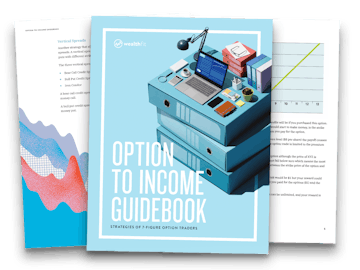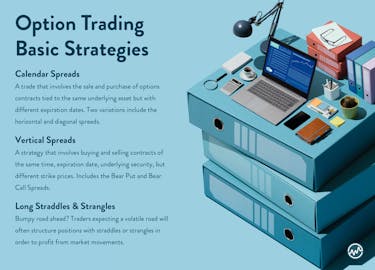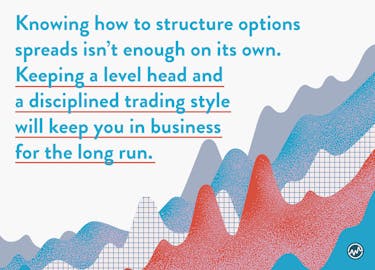
The Options-to-Income Guidebook
In This Article
It’s simple to come up with a plan. It takes skill to adjust the plan when life throws you a curveball — especially with investing your hard earned money.
In my time standing in the trading pits of the Chicago Board of Trade, I was put in a number of high-pressure trading situations over the years.
I found that no matter how much preparation went into a trading strategy, winners and losers were determined by the trader’s ability to use a wide variety of strategies in a disciplined manner.
In this article, we will give an overview of just that: options trading strategies that can be utilized in different market conditions, whether the markets are bullish, bearish, stagnant or volatile.
How Can You Make Money Trading Options?
Understanding simple options trading strategies can enhance a trader's profitability. Why? Options are one of the most versatile tools of the financial markets.
Whether the market is moving up, down, or sideways, options allow investors to enter the market with lower cost and lower risk than trading the underlying asset on its own.
We’ll walk through 6 commonly used options spreads, including their risks, rewards, and an example of why the strategy may be employed.
But before we go any further, let’s ensure that you understand the basics of options trading.
What’s The Difference Between A Call And A Put?
All options trading strategies are built upon the two basic types of options: the call and the put.
There are two just types of options: one that gives you the right to buy the underlying contract, and one that gives you the right to sell the underlying contract.
- A call is an option that offers the right but not the obligation to buy an underlying asset at a certain date for a predetermined price.
- A put is an option that offers the right but not the obligation to sell an underlying asset at a certain date for a predetermined price.
Need a refresher course? Read this Options Guide before going any further.
Ready To Put Those Concepts Together?
Options can be structured in a number of ways, often in combination with other options. An options spread consists of taking a position on two or more different options contracts that are based on the same underlying security.
With odd names and infinite combinations, options trading spreads are strategies that can range from very simple to quite complex, with a variety of reasons why a trader would choose each one.
Need a refresher course? Read this “Options Trading Made Simple” Guide before going any further.
This may sound confusing, so let’s break down the basics of how and why several options trading strategies allow investors to make bets on market behavior — regardless of direction.

6 Options Trading Strategies
Calendar Spreads
A calendar spread is a trade that involves the sale and purchase of options contracts tied to the same underlying asset but with different expiration dates, the risk “spread” against each other. Another term for a calendar spread is a time spread.
Let’s look at two variations of calendar spreads: horizontals and diagonals.
The first version — horizontals — spreads contracts with the same strike price but different expiration dates.
The second version — diagonals — spreads contracts with the different strike prices and different expiration dates
Strategy 1: Horizontal Spread
A horizontal call spread is a calendar spread where only calls are involved, and the contracts have the same strike price.
Similarly, a horizontal put spread is a calendar spread where only puts are involved, and the contracts have the same strike price.
(Example: With ABC stock trading at 85, sell 1 Mar ABC 90 call and buy 1 April ABC 90 call in tandem.)
Strategy 2: Diagonal Spread
A diagonal call spread is a calendar spread where only calls are involved, and the contracts have the same strike price.
Similarly, a diagonal put spread is a calendar spread where only puts are involved, and the contracts have the same strike price.
(Example: With ABC stock trading at 85, sell 1 Mar ABC 90 call and buy 1 April ABC 95 call in tandem.)
When To Employ This Strategy
In a nutshell, it comes down to risk management.
A naked (unhedged) short (sale) of an option would require high margin requirements, and an unhedged long option can tie up a significant portion of your available capital and lose money by time decay (decline in value due to time) if it doesn’t move in the money.
A calendar spread allows a trader to potentially profit from time decay without requiring a large margin and also without being exposed to too much risk.
The difference in strategy between a horizontal and a diagonal is dependent upon whether the trader anticipates movement in the underlying in the time period between the expiration dates of the first and second contracts.
[ DOWNLOAD: Wanna start trading ASAP? Get our free Options-to-Income Guidebook: Strategies of 7-Figure Option Traders today and start trading options in your spare time ]
Keep It Tight: Vertical Spreads
Expecting a directional movement?
A vertical spread is a strategy that involves buying and selling contracts of:
- same type
- same expiration date
- same underlying security
- different strike prices
Thinking of a spreadsheet (the layout of a typical options trading platform), the strikes would fall in the same “vertical,” hence the name.
Strategy 3: Bear Put Spread
This bearish strategy involves buying puts and selling an equal number of puts with a lower strike price.
The contracts are based on the same underlying and have the same expiration date. This will result in a premium, meaning an upfront cost, because the options you buy will be more expensive than the ones you write.
(Example: With ABC stock trading at 85, buy 1 Mar ABC 83 put and sell 1 Mar ABC 82 put in tandem.)
Strategy 4: Bull Call Spread
This bullish strategy involves buying calls and selling an equal number of calls with a higher strike.
The contracts are based on the same underlying and have the same expiration date.
This will result in a premium, meaning an upfront cost, because the options you buy will be more expensive than the ones you write.
(Example: With ABC stock trading at 85, buy 1 Mar ABC 87 call and sell 1 Mar ABC 88 call in tandem.)
When To Employ This Strategy
In general, these strategies are employed to make a bet on the direction when you are reasonably confident of how far the price of the underlying will move.
When you spread the purchase of an option with a sale of a nearby strike price, you limit your profits — but also limit your losses.
It's up to you to decide which strike to use when writing the contracts, but a good general rule is to use a strike that is approximately the same as what you expect the price of the underlying security to be at the time of expiration.
Making Moves: Long Straddles and Strangles
Bumpy road ahead? Traders expecting a volatile road will often structure positions with straddles or strangles in order to profit from market movements.
While these strategies can potentially return unlimited profits if the price of the underlying makes a sizable move in either direction, the trader may lose most (or all) of the premium (purchase price) if market movement is stagnant.
You can keep the cost down by buying contracts that are close to expiration, but this will allow less time for the price of the underlying security to move.
Buying contracts with more time until expiration will be slightly more expensive, but it will give you a greater chance of making a profit.
Strategy 5: Long Straddle
A long straddle involves the purchase of an equal number of long calls and long puts, using the money options contracts.
The options are tied to the same underlying with the same expiration date.
(Example: With ABC stock trading at 85, buy 1 Mar ABC 85 put and buy 1 Mar ABC 85 call in tandem.)
Strategy 6: Long Strangle
A long strangle involves the purchase of an equal number of out of the money puts and out of the money calls tied to the same underlying with the same expiration date.
It has the same objective (volatility/movement) as a straddle but will require less capital since the options are out of the money.
That being said, a long strangle is a debit spread, so there's an upfront cost involved and time decay will eat away at the premium if volatility/movement is not realized.
(Example: With ABC stock trading at 85, buy 1 Mar ABC 80 put and buy 1 Mar ABC 95 call in tandem.)
When To Employ This Strategy
In general, these strategies are employed to try and generate returns from a volatile outlook.
Regardless of which direction the price of the underlying moves, there are opportunities to capture profits — if it moves significantly.
Now that you understand what tools are in your toolbox, how do you decide which tools to use?
Options Trading Considerations
Think about current conditions and your market outlook. The following considerations may influence your next move:
Now or Later?
You can minimize the risk and cost of a directional bet by going long a calendar spread. In the case of a long calendar spread, the bet is a short-term neutral sentiment, with market movement coming into play after the expiration of the shorter-dated option.
Up or Down?
Are you positive or negative on the direction of your underlying price?
If you are forecasting a move upward, consider a bull call spread.
Expecting a move downward? Look into a bear put spread.
Unlike a naked call or put, these spreads allow you to take a stance on the direction while reducing the premium involved.
Stop or Go?
Do you expect a period of uncertainty, which may lead to more market movement than usual?
Regardless of market direction, long straddles and strangles give investors opportunities to capitalize on skittish markets.
Options Trading Strategies
While these strategies are fairly straightforward, they can make a trader successful — but they aren’t risk-free.
It’s important to utilize trading simulation software and, after that, start slow when you begin trading.
Even the most level headed traders will find themselves sweating when the markets throw a curveball, so go into your trades understanding your risks and knowing your limits.
What can increase the chances of success in any market condition?
- discipline
- patience
- adaptability
These basic options strategies give you various opportunities to capture profit whether the market is bearish or bullish, volatile or stagnant.
Regardless of what strategies you choose, it’s essential to understand the fundamental purpose of the trade and how that fits in with your market acumen and risk tolerance.
The value of employing spreads in options trading, whether your hedges include variations in strike price, expiration date, or both, is the ability to limit risk and have the ability to engage in almost any type of market conditions.
That being said, knowing how to structure options spreads isn’t enough on its own.

Continued Learning
If you’d like to continue learning about options or grow your financial education, explore these free resources:
- Here is a short and simple guide to employee stock options
- Learn how to sell puts like Warren Buffet
- Discover how to perform a security risk analysis
- Find out how to read a stock in 60 seconds
- Discover these other investment opportunities, such as real estate, oil or gold






